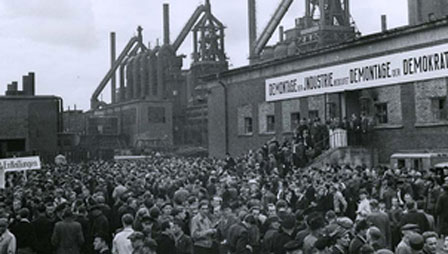StronSal® galvanized products
General properties of StronSal®

StronSal®, a hot-dip coating for steel products, provides ultimate corrosion protection properties that add up to a high performance coating for all applications where zinc-plated steel is essential.
- StronSal® consists of zinc and small fractions of magnesium (1 to 2%) and aluminum (1 to 2%).
- StronSal® offers extraordinary corrosion protection with coating layers of constant properties and considerably reduced thickness by comparison with standard hot-dip galvanized layers (Z). Salt spray tests returned a corrosion resistance two to six times higher compared to standard zinc coating.
- StronSal® convinces with superior varnish adhesion.
- StronSal® offers improved cutting edge protection. Thanks to its special resistance against corrosion, the protective effect achieved with this anticorrosive plating is significantly higher than the effects produced by standard products, also after processing.
- StronSal® offers tremendous resource saving potential thanks to the zinc savings achieved. Our latest product developments make substantial, sustained contributions to environmental protection.
StronSal® – Response to forming processes
Friction values are a decisive factor in terms of forming response and therefore determine process reliability in component production. The friction value developing in the single-stage forming processes can be compared to that of a hot-dip galvanized or electrolytic galvanized finish. As opposed to materials with hot-dip galvanized or electrolytic galvanization, cold welding does not develop in multi-stage forming processes.
StronSal® – Welding suitability
Apart from laser welding, resistance spot welding still represents one of the primary joining processes employed in body-in-white construction. Both welding methods can be applied as in hot-dip galvanized materials.
StronSal® – Varnishing / phosphating
Phosphating, as inorganic conversion layer on the metallic surface, is a decisive factor for the subsequent varnishing process. A phosphate layer of appropriate quality facilitates outstanding varnishing results. StronSal® material can be phosphated to suit specific automotive applications. The varnishing response is identical to that on materials with hot-dip galvanized or electrolytic galvanized finish.
StronSal® – Immediate benefits
StronSal® allows a reduction of the zinc layer thickness while maintaining corrosion protection properties of equivalent quality, i.e. corrosion protection is increased while the zinc layer thickness remains constant. StronSal® represents an alternative to piece galvanizing.
Thin metal sheet finished with StronSal® is produced at galvanization plant 1 and 2 of Salzgitter Flachstahl. The zinc coating is applied to the steel strip in a liquid zinc bath at a temperature of approx. 450 °C. The required layer thickness is set up by means of wiper nozzles.
Using the in-line finishing racks, a Pretex® fine-finish structure is set up to meet high demands made in further processing. A stretch leveler ensures strip levelness, and post treatment in the passivation process improves the anticorrosive properties of the finish for storage and transport.
The material can be passivated without using hexavalent chrome. Prelube can be applied for oiling.







